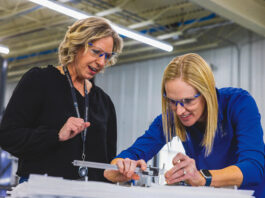A startup energy company — with an early-stage hybrid energy system and near-shore buoy technologies — has its sights on harnessing the power of ocean waves more effectively than ever before. The company, Laminar Scientific, has already found success in the form of funding from a $150,000 grant from the Department of Energy, pebble funds […]
Want to Read More?
Get immediate, unlimited access to all subscriber content and much more.
Learn more in our subscriber FAQ.
Subscribe Now
A startup energy company — with an early-stage hybrid energy system and near-shore buoy technologies — has its sights on harnessing the power of ocean waves more effectively than ever before.
The company, Laminar Scientific, has already found success in the form of funding from a $150,000 grant from the Department of Energy, pebble funds from the Builders + Backers entrepreneur accelerator program in Iowa City, nearly $130,000 from an online crowdfunding service and $200,000 from family and friends. Laminar also signed a Memorandum of Understanding with an overseas energy firm, based on the success of its inventions so far.
Those inventions are backed by four pending patents, with that number possibly rising to seven.
Major patents
One of the major patents is a special gearbox that converts multi-directional movement into unidirectional movement using magnetic motion rectifier designs, which is then fed into a generator for more efficient electricity. The gearbox won’t be part of the first version of the buoy.
Laminar estimates the technology can power up to 76 homes by generating 2,200 kilowatts per day. When given a specific volume, he says you’re able to get 62.5 times more energy on average than from other renewable energy sources like wind or solar.
Since the buoy systems will be installed and stick out partially above water, Laminar’s designs are meant to be less dangerous and more cost-effective, said Narayan Iyer, co-founder and CEO of Laminar Scientific.
“Essentially, this installation removal system is quite important for us because we’re able to see that maintenance is a huge barrier in this industry,” he said. “We believe this solution can bring ocean energy into the mainstream.”
Expanding in the midwest
Laminar’s wave energy converters could become the lowest cost system on the market, meaning the installation process will be relatively easy and won’t require divers or drones. Common troubles in the industry like biofouling, or the accumulation of organisms and algae on surfaces which causes structural damage, should also be minimized with Laminar’s products.
Mr. Iyer is a former aerospace systems engineer at Rockwell Collins. He was test lead on the NASA X59 and Airbus C295 projects, but felt deeply about turning his attention toward inventing solutions to help solve climate change.
Using the University of Iowa’s IIHR — Hydroscience & Engineering lab, he was able to simulate ocean waves right here in Iowa. While his inventions won’t be deployed in a Midwestern inland state, he says there’s no reason why research and future manufacturing efforts can’t happen locally.
“I see Iowa as the place to expand,” he explained. “The product may never be used here, but neither are F-16 fighter jets from Collins Aerospace.”
Within two years, Mr. Iyer hopes to have the first buoy piloted and demonstrated. Over the next three to four years, he wants to continue seeking funding so Laminar can eventually afford to build the buoys outside of India.
The cost of innovation
The cost to produce the first buoy could reach $130,000. In Indonesia, where pilot testing will take place, the same buoy will return about a $80,000 per year return as a conservative estimate.
For now, Mr. Iyer and his team will forgo the manufacturing route and instead focus on licensing, since it is a “faster income stream” and allows the company to expand the tech into southeast Asia.
While in the past, ocean energy has faced issues regarding maintenance, and is rarely used outside of special military missions, Mr. Iyer sees a world where energy from waves is commonplace.
“What we’re trying to do is design the system for the majority of humans on Earth, even those who are income-restricted,” he said. “Once it is ironed out, the U.S. will be the biggest market. There’s just so much potential.”
